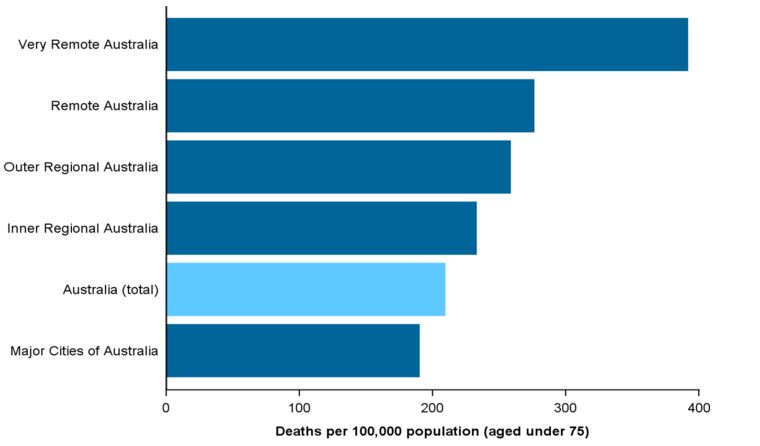News
Australian death rate in 2020 lowest on record: AIHW
All-cause mortality rates declined by 7.7% from 2019, but there was one PHN where 67% of deaths were still considered ‘premature’.
 Age-standardised mortality rates reached their lowest ever recorded level in 2020. (Image: AIHW)
Age-standardised mortality rates reached their lowest ever recorded level in 2020. (Image: AIHW)
The arrival of COVID-19 saw global death rates increase for the first time in decades, with the World Health Organization (WHO) estimating that pandemic had led to at least three million excess deaths in 2020 alone.
High income countries were hit particularly hard, recording one additional death per 100,000 people during this period, but Australia’s success in stiflling large-scale outbreaks, combined with health restrictions that saw millions of people restricted to their homes for weeks or months at a time, saw overall mortality rates track in the opposite direction.
Now, data released today by the Australian Institute of Health and Welfare (AIHW) has provided even more detail on mortality in the country across this key 12-month period.
According to the AIHW, age-standardised mortality rates for all causes combined reached their lowest recorded level in 2020 of 487.7 deaths per 100,000 people, down from 528.4 in 2019.
The 40.7 fewer deaths per 100,000 people is the biggest drop since 1988 (54.4) while the 8001 fewer deaths in 2020 compared to the previous year is the largest annual decrease since they dropped by 9641 in 1920.
Overall, 161,300 people died in Australia in 2020.
The reduced mortality rates also seem to have contributed to Australian men and women both recording their highest ever average age at death (74.6 and 80 years, respectively). The overall median age at death was 81.7 years, which has remained stable for more than 10 years.
However, even though the average Australian appears to be living longer, a review of data divided by Primary Health Network (PHN) shows major gaps remain, depending on where a person lives.
The best and worst performing PHNs
Northern Sydney recorded the lowest rates across all three major metrics measured by the AIHW – total deaths per 100,000, premature deaths (those aged under 75), and potentially avoidable deaths.
Eastern Melbourne, Central and Eastern Sydney and Gold Coast were the other PHNs that were in the bottom five across all categories, while Perth North performed strongly in total deaths and premature deaths.
The difference between the best and worst performing PHNs when measured by these statistical categories is stark.
Western Queensland, the PHN with the most age-standardised deaths per 100,000 people, recorded a rate almost double that of Northern Sydney (671.1 vs 366.6), while Northern Territory PHN was only marginally lower at 641.1 deaths per 100,000.
Likewise, more than two thirds of all deaths in the Northern Territory PHN (67.2%) were assessed as being premature, compared to less than a quarter (23.3%) in Northern Sydney, and 34.1% nationwide.
What impact does remoteness have on deaths?
The AIHW figures present a consistent trend on mortality – the further you live from a major city, the more likely you are to die prematurely or from avoidable causes.
 The chance of premature death increases the further remote you are in Australia, new AIHW statistics suggest (Image: AIHW)
The chance of premature death increases the further remote you are in Australia, new AIHW statistics suggest (Image: AIHW)
People who live in very remote parts of the country are particularly vulnerable. The more than 107,000 people who reside in very remote areas are 1.33 times more likely to die when compared to the nationwide mortality rate, while 67.9% of those deaths will be premature.
Moreover, the median age of death in very remote parts of Australia is 66, more than 16 years younger than people who live in major cities, where the median is 82.4.
The vast majority of these figures decline on a gradient, with the best performing rates in major cities, followed by inner regional, outer regional, remote and very remote.
What did people die from?
Coronary heart disease remains the leading cause of death for Australian men, with 52,886 instances in 2020, more than double the next highest cause (dementia, 25,219).
It is the opposite for women, albeit with a smaller gap. Dementia was listed as the cause of death for 45,201 women in 2020, followed by coronary heart disease on 37,640.
Across all people, the top 10 leading causes of death in 2020 were:
- Coronary heart disease (90,526 total deaths)
- Dementia including Alzheimer’s disease (70,420)
- Cerebrovascular disease (50,000)
- Lung cancer (42,544)
- Chronic obstructive pulmonary disease (COPD) (35,718)
- Colorectal cancer (26,602)
- Diabetes (24,414)
- Influenza and pneumonia (17,159)
- Heart failure and complications and ill-defined heart disease (16,984)
- Prostate cancer (16,971)
Log in below to join the conversation.
AIHW coronary heart disease COVID-19 dementia mortality
newsGP weekly poll
As a GP, would you benefit from further education about identifying and supporting patients impacted by intimate partner violence?